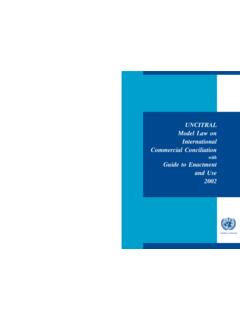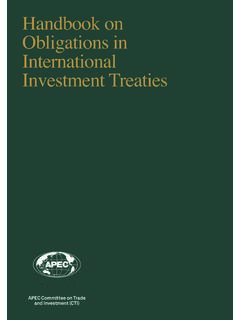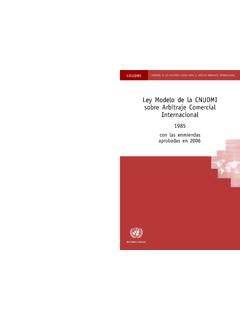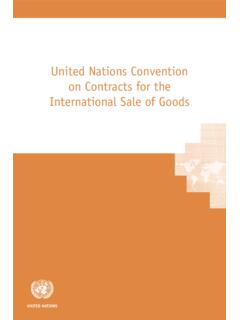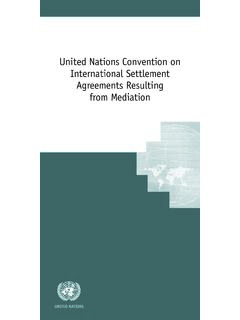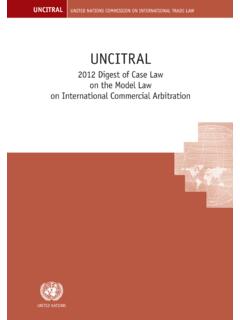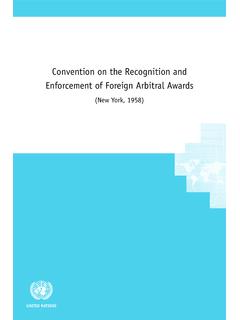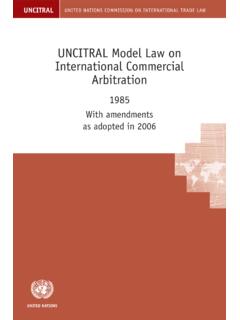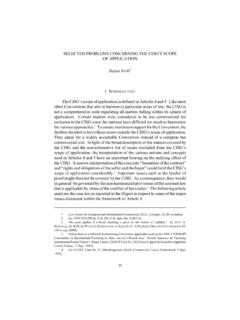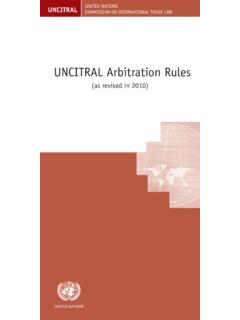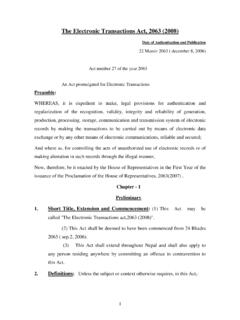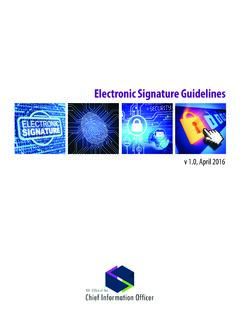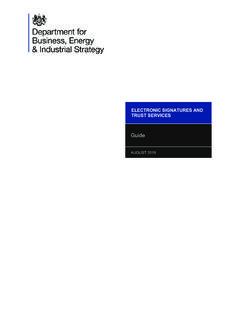Transcription of UNCITRAL Model Law on Electronic Signatures
1 Printed in April 2002 5,600 United Nations publicationSales No. 92-1-133653-8 UNITED NATIONSUNCITRAL Model Law onElectronic SignatureswithGuide to Enactment2001 UNCITRALM odel Law onElectronic SignatureswithGuide to Enactment2001 UNITED NATIONSNew York, 2002 United Nations PublicationSales No. 92-1-133653-8 ContentsPageResolution adopted by the General Assembly .. viiPart OneUNCITRAL Model LAW ON Electronic Signatures (2001)Article of application ..1 Article ..1 Article treatment of signature technologies ..2 Article ..2 Article by agreement ..2 Article with a requirement for a signature ..2 Article of article 6 ..3 Article of the signatory ..3 Article of the certification service provider ..4 Article 10. Trustworthiness ..5 Article 11.
2 Conduct of the relying party ..5 Article of foreign certificates and Electronic Signatures ..6 Part TwoGUIDE TO ENACTMENT OF THE UNCITRAL Model LAWON Electronic Signatures (2001)Purpose of this Guide ..7 Chapter I. Introduction to the Model Law ..8I. PURPOSE AND ORIGIN OF THE Model LAW ..8A. Purpose ..8B. Background ..9C. History .. Model LAW AS A TOOL FOR HARMONIZING LAWS .. REMARKS ON Electronic Signatures .. 19A. Functions of Signatures .. 19B. Digital Signatures and other Electronic Signatures .. 201. Electronic Signatures relying on techniques other thanpublic-key cryptography .. 21iiiivPage2. Digital Signatures relying on public-key cryptography .. 22(a)Technical notions and terminology.
3 22(i) Cryptography .. 22(ii) Public and private keys .. 22(iii) Hash function .. 23(iv) Digital signature .. 24(v) Verification of digital signature .. 24(b)Public-key infrastructure and suppliers of certificationservices .. 25(i) Public-key infrastructure .. 26(ii) Certification service provider .. 27(c)Summary of the digital signature process .. 30IV. MAIN FEATURES OF THE Model LAW .. 31A. Legislative nature of the Model Law .. 31B. Relationship with the UNCITRAL Model Law on ElectronicCommerce .. 321. New Model Law as a separate legal instrument .. 322. New Model Law fully consistent with the UNCITRALM odel Law on Electronic Commerce .. 323. Relationship with article 7 of the UNCITRAL Model Law onElectronic Commerce.
4 33C. "Framework" rules to be supplemented by technical regulationsand contract .. 34D. Added certainty as to the legal effects of Electronic Signatures .. 34E. Basic rules of conduct for the parties involved .. technology-neutral framework .. 38G. Non-discrimination of foreign Electronic Signatures .. 38V. ASSISTANCE FROM THE UNCITRAL SECRETARIAT .. 38A. Assistance in drafting legislation .. 38B. Information on the interpretation of legislation based on theModel Law .. 39 Chapter remarks .. 39 Title .. 39 Article of application .. 40 Article .. 42 Article treatment of signature technologies .. 47 PageArticle .. 48 Article by agreement .. 50 Article with a requirement for a signature.
5 51 Article of article 6 .. 57 Article of the signatory .. 60 Article of the certification service provider .. 63 Article 10. Trustworthiness .. 66 Article 11. Conduct of the relying party .. 67 Article 12. Recognition of foreign certificates and electronicsignatures .. 69vviiResolution adopted by the General Assembly[on the report of the Sixth Committee (A/56/588)]56/80 Model Law on Electronic Signaturesadopted by the United NationsCommission on InternationalTrade LawThe General Assembly,Recallingits resolution 2205 (XXI) of 17 December 1966, by which it estab-lished the United Nations Commission on International Trade Law, with a mandateto further the progressive harmonization and unification of the law of internationaltrade and in that respect to bear in mind the interests of all peoples, and particu-larly those of developing countries, in the extensive development of internationaltrade,Notingthat an increasing number of transactions in international trade arecarried out by means of communication commonly referred to as Electronic com-merce, which involves the use of alternatives to paper-based forms of communi-cation, storage and authentication of information.
6 Recalling the recommendation on the legal value of computer records adop-ted by the Commission at its eighteenth session, in 1985, and paragraph 5 (b) ofGeneral Assembly resolution 40/71 of 11 December 1985, in which the Assemblycalled upon Governments and international organizations to take action, whereappropriate, in conformity with the recommendation of the Commission,1so as toensure legal security in the context of the widest possible use of automated dataprocessing in international trade,Recalling alsothe Model Law on Electronic Commerce adopted by the Com-mission at its twenty-ninth session, in 1996,2complemented by an additional ar-ticle 5 bis adopted by the Commission at its thirty-first session, in 1998,3andparagraph 2 of General Assembly resolution 51/162 of 16 December 1996.
7 In whichthe Assembly recommended that all States should give favourable consideration tothe Model Law when enacting or revising their laws, in view of the need for uni-formity of the law applicable to alternatives to paper-based methods of communi-cation and storage of information,1 Official Records of the Genreal Assembly, Fortieth Session, Supplement No. 17(A/40/17),chap. VI, sect. , Fifty-first Session, Supplement No. 17 (A/51/17), para. , Fifty-third Session, Supplement No. 17 (A/53/17), chap. III, the Model Law on Electronic Commerce is of significant assis-tance to States in enabling or facilitating the use of Electronic commerce, as demon-strated by the enactment of that Model Law in a number of countries and itsuniversal recognition as an essential reference in the field of Electronic commercelegislation,Mindfulof the great utility of new technologies used for personal identifica-tion in Electronic commerce and commonly referred to as Electronic Signatures ,Desiringto build on the fundamental principles underlying article 7 of theModel Law on Electronic Commerce4with respect to the fulfilment of the signa-ture function in an Electronic environment.
8 With a view to promoting reliance onelectronic Signatures for producing legal effect where such Electronic signaturesare functionally equivalent to handwritten Signatures ,Convincedthat legal certainty in Electronic commerce will be enhanced bythe harmonization of certain rules on the legal recognition of Electronic signatureson a technologically neutral basis and by the establishment of a method to assessin a technologically neutral manner the practical reliability and the commercialadequacy of Electronic signature techniques,Believingthat the Model Law on Electronic Signatures will constitute a use-ful addition to the Model Law on Electronic Commerce and significantly assistStates in enhancing their legislation governing the use of modern authenticationtechniques and in formulating such legislation where none currently exists,Being of the opinion that the establishment of Model legislation to facilitatethe use of Electronic Signatures in a manner acceptable to States with differentlegal, social and economic systems could contribute to the development of har-monious international economic relations.
9 Its appreciationto the United Nations Commission onInternational Trade Law for completing and adopting the Model Law on ElectronicSignatures contained in the annex to the present resolution, and for preparing theGuide to Enactment of the Model Law;2 Recommendsthat all States give favourable consideration to the ModelLaw on Electronic Signatures , together with the Model Law on ElectronicCommerce adopted in 1996 and complemented in 1998, when they enact or revisetheir laws, in view of the need for uniformity of the law applicable to alternativesto paper-based forms of communication, storage and authentication of information;3 Recommendsalso that all efforts be made to ensure that the Model Lawon Electronic Commerce and the Model Law on Electronic Signatures , togetherwith their respective Guides to Enactment, become generally known and plenary meeting12 December 20014 General Assembly resolution 51/162, OneUNCITRAL Model Law on Electronic Signatures (2001)Article 1.
10 Sphere of applicationThis Law applies where Electronic Signatures are used in the context*of commercial** activities. It does not override any rule of law intendedfor the protection of the purposes of this Law:(a) Electronic signature means data in Electronic form in, affixedto or logically associated with, a data message, which may be used to iden-tify the signatory in relation to the data message and to indicate the sig-natory s approval of the information contained in the data message;(b) Certificate means a data message or other record confirming thelink between a signatory and signature creation data;(c) Data message means information generated, sent, received orstored by Electronic , optical or similar means including, but not limited to, Electronic data interchange (EDI), Electronic mail, telegram, telex or tele-copy.
